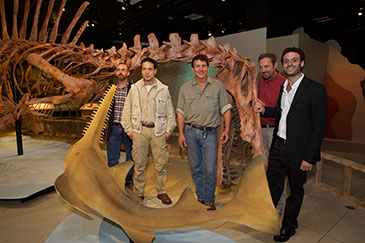The fossils also indicate that Spinosaurus was the largest known predatory dinosaur to roam the Earth, measuring more than nine feet longer than the world’s largest Tyrannosaurus rex specimen.
The research, published today in the journal Science, was led by Dr Nizar Ibrahim of the University of Chicago, a recent graduate of the University of Bristol, and co-authored by an international team of scientists including Matteo Fabbri, currently a Masters student in Bristol's School of Earth Sciences.
The researchers analysed new fossils uncovered in the Moroccan Sahara along desert cliffs known as the Kem Kem beds (an area that was once a large river system) and a partial Spinosaurus skull and other remains housed in museum collections around the world.
They also studied historical records and images from the first reported Spinosaurus discovery by German palaeontologist Ernst Freiherr Stromer von Reichenbach in the Egyptian Sahara more than a century ago. Sadly, all of Stromer's fossils were destroyed during the April 1944 Allied bombing of Munich.
To unlock the mysteries of Spinosaurus, the team created a digital model of the skeleton with funding provided by the National Geographic Society. The researchers CT-scanned all of the new fossils, complementing them with digital recreations of Stromer's specimens. Missing bones were modelled based on known elements of related dinosaurs.
The researchers then used the digital model to create an anatomically precise, life-size 3-D replica of the Spinosaurus skeleton. After it was mounted, the researchers measured Spinosaurus from head to tail, confirming their calculation that the new skeleton was longer than the largest documented Tyrannosaurus by more than 9 feet.
Dr Ibrahim said: "Working on this animal was like studying an alien from outer space; it's unlike any other dinosaur I have ever seen."
The aquatic adaptations of Spinosaurus differ significantly from earlier members of the spinosaurid family that lived on land but were known to eat fish.
These adaptations include small nostrils in the middle of the skull that would have allowed Spinosaurus to breathe when part of its head was in water; giant, slanted teeth well-suited for catching fish; a long neck and trunk that shifted the dinosaur's centre of mass forward making walking on two legs on land nearly impossible but facilitating movement in water; and strong, long-boned feet and long, flat claws similar to some shorebirds that stand on or move across soft surfaces rather than perch. In fact, Spinosaurus may have had webbed feet for walking on soft mud or paddling.
Spinosaurus also had enormous dorsal spines covered in skin that created a gigantic 'sail' on its back. The tall, thin, blade-shaped spines were anchored by muscles and composed of dense bone with few blood vessels. This suggests the sail was meant for display and not to trap heat or store fat. The sail would have been visible even when the animal entered the water.
Matteo Fabbri, who conducted the osteo-histological analysis regarding the ontogenetic stage of the new skeleton of Spinosaurus, the function of the sail and the adaptation to water, said: "The incredible adaptations evolved by this animal finally confirm that aquatic dinosaurs existed, resolving a 150 years old controversy. The bone microstructural features are more similar to those found in early whales and penguins than in other gigantic theropods such as Tyrannosaurus. Spinosaurus completely changes our point of view about predatory dinosaurs and opens a new perspective for the investigation of this group."
The life-size skeletal replica will be the centrepiece of a new exhibition Spinosaurus: Lost Giant of the Cretaceous at the National Geographic Museum in Washington, D.C. The global search to uncover the Spinosaurus skeleton and its mysteries will also be featured in a National Geographic/NOVA special, 'Bigger Than T.rex'.
Paper
'Semiaquatic Adaptations in a Giant Predatory Dinosaur' by N. Ibrahim, P. C. Sereno, C. Dal Sasso, S. Maganuco, M. Fabbri, D. M. Martill, S. Zouhri, N. Myhrvold and D. A. Iurino in Science
